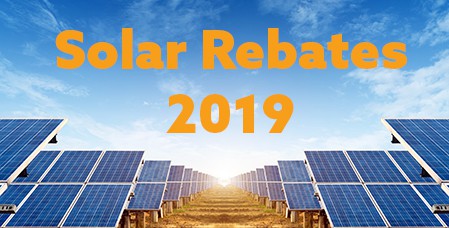Opting for solar energy for residential and commercial use can reduce your overall monthly bills over time.

However, the option does not come cheap, to begin with. With this in mind, the government has put several energy efficiency programs and green incentives in place for people seeking to go solar. These energy efficiency programs include cash rebates and green incentives. Cash rebates reduce the overall costs for purchasing energy saving appliances and solar technologies. This is done to encourage more people to go for cleaner, more efficient, renewable energy solutions.
What are energy rebates and which are available to you?

What are energy rebates?
An energy rebate program or an energy credit incentive program provides a cash refund program for customers who want to install newer energy efficient technologies. With rebates, you get a refund of a portion of their total purchase price. This differs from a discount in that a discount allows you to purchase something at a lower cost.

Tax Deduction Benefit
Solar technologies also offer a tax deduction benefit and can reduce your federal tax burden by up to $5,490. A tax deduction reduces your taxable income, while a tax credit reduces your tax dollar for dollar.

Solar Energy Tax Credit
This is available to homeowners and businesses alike. This investment credit tax for solar applies for both solar panel systems and solar hot water systems and is worth 30% of the purchase and installment cost.
Therefore if your system cost you $10,000, then you would be owed $3,000 credit. This credit was extended by Congress at the end of 2015, and this gives solar energy owners until end 2019 to claim the 30% benefit. After this period, the benefit will go down a few percentages till 2022. This facility is only advanced to owners. If say you are to lease your solar panels, you would be exempt from the facility. The company that leases the system to you makes the claim and gets the incentives.
This is one advantage of buying as opposed to leasing. While leasing is cheaper, you miss out on the tax credit. For an owner, the tax credit is a drawback in getting a positive ROI from your solar panel system

How to claim a federal tax credit
It goes without saying that the larger your investment, the more you are owed. So the first step is to keep all receipts and track everything.
The eligible costs include:
- Solar equipment
- Freight shipping costs
- Equipment purchased or rented for the installation
- Assembling and installation costs
- Labor costs like piping and wiring.
- Engineers fees
- Electrician’s fees
- Permitting service costs
- If you hire a contractor, you can claim his fees as well. However, if you decide to do your own installation, you can not claim labor costs.
For a residential claim, you need to fill in IRS Form 5695. Then gather all your expense sheets and evidence. Complete IRS form 5965 to add up all your renewable energy credits. Then add your energy credit information to form 1040, and its ready for submission.
If the tax credit exceeds the homeowner’s tax liability, then a percentage of the tax credit can be carried forward to the next year.

Energy Efficient Appliances: ENERGY STAR Rebates
In the US, an ENERGY STAR system is used to connote appliances that use less energy. These include dryers, refrigerators, heating appliances and so on.
However, energy efficient appliances come at a premium which discourages people from buying them. Again, to encourage purchase of energy efficient appliances, the government has put certain incentives for people buying energy-efficient appliances as well. Lower renewable energy bills are a plus for people who go for energy efficient technologies.
These rebates range from $10 for light bulbs to $1000 for much larger equipment. When you receive your rebates is dependent on your State’s policy as well the product you are making a rebate claim against. While some rebates are only availed after installation, others are disbursed to you immediately after purchase. Here are some:
1. Energy efficient electric dryer
Clothes dryers are among the highest energy consuming appliances in the home. A dryer’s consumption is equal to that of a refrigerator, washing machine and dishwasher per year combined. An energy efficient electric dryer will consume 20% less energy. For people that invest in ENERGY STAR models, they get to save on their renewable energy bills as well.
2. Incentives for upgrading to the most energy efficient refrigerator
The most energy efficient refrigerator uses up to 40% less energy than conventional refrigerators. In Massachusetts’ energy saving program, you get a $200 rebate for buying an energy efficient refrigerator. There are also benefits for recycling your old unit.
3. Dishwasher
Dishwashers typically do not consume much energy when compared to refrigerators and clothes dryers. This notwithstanding, rebates again can help reduce the cost to replace dishwasher.
For a dishwasher, its water and electrical costs stack up. Energy certified dishwashers will save you up to 12% more than a conventional washer. Such savings, coupled with incentives from government incentive programs significantly reduces the cost to replace dishwasher.
4. Energy efficient windows
You claim your list of tax credits by filing the previous year’s taxes. If you have made a purchase that is within the eligibility criteria during that year, you are allowed to deduct the amount from your tax lien. Energy efficient windows are in this criteria.
Heat loss and gain comes from windows. Energy efficient windows can regulate this and tax your heating appliances significantly less. To meet the eligibility criteria, you have to make three or more eligible energy efficient upgrades to your home. Under this criteria, you receive a $750 rebate from government incentive programs. ENERGY STAR windows are eligible for this. This is a home improvement tax credit you can add to your list of tax credits you qualify for this year.

Conclusion
With home improvement tax credit and rebates available to you, as well as the benefits of solar to the environment and to your finances, it’s definitely worth your time to make the applications if you already own eligible appliances. If you had not made the plunge, considering the benefits you will get, the time to go solar is definitely now. Past 2019 through to 2022, the credits made available will be decreased gradually.
